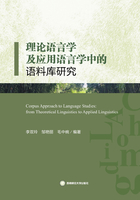
Semantic Sequences, Disciplinarity and Pedagogy: A Corpus-Based Cross-Disciplinary Study
1 Sichuan International Studies University
2 Beihang University
Abstract:This paper presents a corpus-based cross-disciplinary investigation into the relationship between semantic sequences (i. e. sequences of meaning elements which capture both surface and underlying regularities of language in use)and disciplinary epistemology. The corpora used are compiled of research articles which are written by English L1 users and represent distinctive knowledge domains. Focusing on the pattern V that, we propose and demonstrate that grammar patterns are useful for identifying semantic sequences in academic discourse. The subsequent analyses reveal that knowledge construction and representation in all academic disciplines are, to varying degrees, objective and evidence-based and that applied disciplines(e.g. Education and Mechanics)prefer more objective ways to construct knowledge than pure sciences(e.g. Linguistics and Physics). The study also lends support to observations about disciplinarity that have been made in previous investigation (e.g. self-sourced knowledge construction in hard sciences versus other-sourced in soft sciences). Looking at both suggests that semantic sequences are advantageous to investigate disciplinary epistemology. Insights offered into the depiction and characterization of academic disciplines, and the pedagogical applications of research on semantic sequences, are further discussed.
Keywords:Semantic Sequences; Disciplinarity; Grammar Pattern; Pedagogy; Academic Writing
1. Introduction
This study investigates the association between phraseology and disciplinary epistemology and further discusses the pedagogical applications for the teaching of academic writing in EAP/EFL contexts. It draws on a recently proposed alternative candidate for the description of phraseo logical behaviour, which is termed“semantic sequence”(Hunston,2008). Briefly, semantic sequences are sequences of semantic elements that are generalized by analyzing linguistic expressions which may be diverse in form but consistent in meaning and/or function (Bondi,2015;Bondi &Diani,2015; Groom,2009,2010; Hunston,2008). The rationale of this study is that“semantic sequences, representing ‘what is often said', are most useful when linked to epistemology in disciplinary discourse”(Hunston,2008:290).
Disciplinary epistemology, which plays a significant role in higher education (Becher, 1981,1994), relates to the ways in which knowledge is constructed in different academic disciplines and the nature of disciplinary knowledge. As Groom notes,
The idea that conceptions of knowledge and approaches to knowledge creation might vary in significant and systematic ways across the academic disciplinary spectrum is not a particularly controversial one. Rather, the problem for researchers has traditionally been one of how to describe this variation in a comprehensive and coherent way.
(Groom,2009:123)
The question, then, is how to capture disciplinary cultures. Becher(1987:261)has rightly pointed out that, if different knowledge fields have their distinctive characteristics, “one would expect differences in fields of knowledge to be reflected in differences in linguistic form, and by the same token, differences in linguistic form to signify differences in fields of knowledge”. Further, he highlighted the “usefulness of the study of linguistic behaviour... in illuminating our understanding of academic disciplines”(Becher,1987:273). In a similar vein, Groom (2005:258)has argued that different discourse communities may select or prioritize different phraseological patterns.
The observation that each discipline has its own distinctive epistemology and the epistemological foundations are encoded in linguistic forms has been evidenced by a number of studies [see Gray (2015:15-18)for a survey]. For instance, Groom's(2005)investigation of the introductory it pattern in Literary Criticism and History shows that language use is motivated by discipline-specific practices. Charles (2006a,2006b,2007), exploring phraseological variations (e.g. N that and V that)in stance construction in Politics and Materials, similarly shows that strategies used to construct authorial stance vary according to disciplines. Recently, Gray(2015) has presented a comprehensive investigation into linguistic variation across both genres and disciplines, which further confirms that language use is discipline-specific. Her study shows that, for example, verb complement clauses are most frequently used in disciplines of humanities (e. g. History), moderately frequently in disciplines of social sciences(e.g. Linguistics), and are least frequently used in hard sciences(e.g. Physics).
The upshot of the above discussion, then, is that disciplinarity is encoded in disciplinary discourses and as such a linguistic analysis can in turn help generalize the epistemology of a given academic discipline. At this point, what should be noted is that previous research investigating disciplinary epistemology mainly focuses on formal features, presenting cross-disciplinary examination of uses of lexical bundles(e.g. Cortes,2004; Durrant,2017; Hyland,2008)or particular phrasal patterns (e. g. Charles,2006a,2006b; Gray & Cortes,2010; Jiang,2017), the question as to whether disciplinary cultures can also be revealed by semantic features, however, has yet not been sufficiently addressed(cf. Karimi,2014). The present study thus sets as its objective to explore empirically the possibility of using a semantic analysis to explore and describe disciplinary epistemology. The aims are threefold:it aims to demonstrate how semantic sequences can be identified in academic discourse, and further aims to show the usefulness of semantic sequences in investigating and characterizing disciplinarity; the ultimate aim is to help raise researchers' awareness of disciplinary cultures and shed light on the teaching of academic writing in EAP/EFL contexts. To that end, the study addresses the following three questions:
· Can semantic sequences be used to capture disciplinary epistemology, specifically, to describe the ways in which knowledge is constructed and represented in different academic disciplines?
· What insights can a semantic sequence analysis offer into the depiction and characterization of academic disciplines?
· What potential pedagogical value can a semantic sequence analysis have for the teaching of academic writing?
The remainder of this paper is organized into 6 further sections. Section 2 provides a detailed discussion of semantic sequences, in particular how semantic sequences can be identified. Section 3 introduces the corpora and method used in the current investigation. Section 4 sketches the analytic process and gives examples for each sequence identified. Section 5 presents the results and discusses major observations that can be drawn from the analyses. Section 6 further discusses the implications and applications of semantic sequence analysis. Section 7 concludes the present study, arguing the importance of more investigation into the association between phraseology and disciplinary epistemology within the analytical frame of semantic sequences.